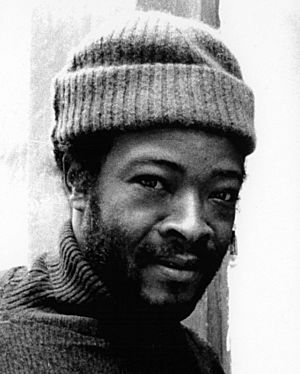Errol Sawyer facts for kids
Quick facts for kids
Errol Sawyer
|
|
|---|---|

Sawyer in Paris, 1973.
|
|
| Born |
Errol Stanley Sawyer
August 8, 1943 |
| Died | December 24, 2020 (aged 77) Amsterdam, The Netherlands
|
| Known for | Photography |
| Movement | Street photography |
| Spouse(s) | Mathilde Fischer, architect |
Errol Stanley Sawyer (born August 8, 1943 – died December 24, 2020) was an American photographer. He spent the last 22 years of his life living and working in Amsterdam, the Netherlands.
Contents
Early Life and Inspiration
Errol Sawyer was born in Miami, Florida. His father, Robert Earl Sawyer, was an African American writer, actor, and director. His mother, Mamie Lucille Donaldson, was African American and Cherokee Indian. She worked as a nurse for 25 years in New York City.
In 1950, Errol moved with his mother and sister to Harlem, New York City. A few years later, they moved to The Bronx. He finished high school in 1961. From 1962 to 1966, he studied history and political science at New York University.
Living near Greenwich Village opened his eyes to a world of art and culture. He also found a passion for chess there, which he loved his whole life. The Woodstock Festival in 1969 greatly influenced his decision to become a photographer. He often visited a club called Max's Kansas City in the 1960s. There, he met famous artists like Jimi Hendrix and Andy Warhol. The photographer Diane Arbus even took his portrait.
Photography Career
Errol Sawyer discovered his love for photography in 1968. This happened while he was traveling in Colombia, Ecuador, and Peru. His first camera was a Kowa. His first professional photography job was in London in 1971. He looked up to photographers like Richard Avedon.
In the early 1970s, Sawyer lived and worked in Paris and London. His photos appeared in popular magazines such as Dépêche Mode, Elle, and French Vogue. He photographed many famous people, including the painter Beauford Delaney and actresses like Jessica Lange. In 1973, he discovered the model Christie Brinkley. He took her first modeling photos and helped her join a top modeling agency.
In 1978, Sawyer moved back to New York. He worked for magazines like New York Magazine and US Vogue. He also did beauty campaigns for big brands like Avon. At the same time, he kept working on his street photography.
Since 1984, Sawyer took on commercial jobs. He also worked on multicultural beauty projects. However, he spent most of his time on documentary and fine art photography. He mainly took black and white photos on the streets of New York, Paris, and Amsterdam. His fine art pictures were published in magazines like The Sun.
From 2006 to 2010, Sawyer was a guest professor of photography. He taught at Technical University Delft in the Netherlands.
In 2010, he released his photo book called City Mosaic. This book has 64 black and white pictures. They are divided into three parts: "Graffiti," "Portraits & City Scenes," and "Perspectives." A photography critic named A. D. Coleman wrote the introduction. He said Sawyer's work showed nearly 40 years of classic street photography. He also noted that Sawyer's photos had their own unique voice.
Photography Style
Errol Sawyer believed a good picture "leaves room for you to imagine." He wanted his photos to make people look closer at everyday things. These are things they might usually miss. He photographed people, graffiti, and different views. He took these pictures in public places like parks, streets, and subway stations.
A critic named Herman Hoeneveld said Sawyer was like a "cultural philosopher." He felt Sawyer wanted people to think and be aware. He believed Sawyer encouraged us not to let our feelings be lost in the rush of buying things.
Art critic Julian Spalding called Sawyer a "classical black and white photographer." He compared him to Henri Cartier-Bresson. Spalding said Sawyer used his camera in a simple but challenging way. He used it "as a trap for catching time." Another painter, Richard Phillips, noted that Sawyer kept his artistic spirit. This was true even though he worked in the commercial photography world.
Exhibitions
Errol Sawyer had solo exhibitions (shows of only his work) at these places:
- 4th Street Gallery, New York City, 1989. The show was called Children of East End.
- Royal Photographic Society, Bath, England, 1992. Also for Children of East End.
- La Musée de la Photographie, Bièvre, France, 1993. The theme was Paris.
- Foto Huset Gallery, Götenburg, Sweden, 1993. The theme was Graffiti.
- No Name Gallery, Basel, Switzerland, 1993. Also for Graffiti.
- La Chambre Claire Gallery, Paris, France, 2000. The show was called City Mosaïc.
- Town Hall, Amsterdam, Netherlands, 2010. The theme was Diofior, A Village in Senegal.
Collections of His Work
Errol Sawyer's photographs are part of important collections around the world:
- La Bibliothèque Nationale, Paris, France, 1974 and 2001. They have 37 of his pictures.
- La Musée de la Photographie, Bièvre, France, 1991. They have 6 pictures.
- Schomburg Center for Research in Black Culture, Harlem, New York, 1997. They have 40 pictures.
- Eric Franck Gallery, London, England, 1997. They have 21 pictures.
- Fadi Zahar, La Chambre Claire Gallery, Paris, France, 2000. They have 4 pictures.
- Manfred Heiting, Amsterdam, Holland, 2002. They have 2 pictures.
- Museum of Fine Arts, Houston, Texas, 2004. They have 2 pictures.
- Victoria & Albert Museum, London. England. His work was added to their National Art Library Collection in 2005.
- Tate Britain, London, England, 2012. They have 21 pictures.

